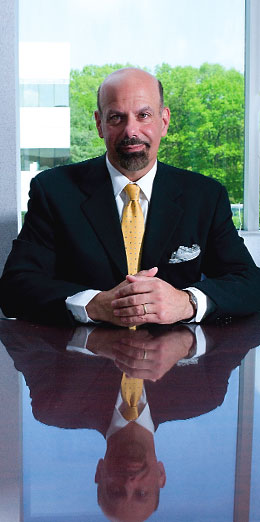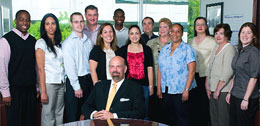|
MARKETING
Making the coverage fit the crime
From armored cars to ATMs, from gaming to government, Great American's Fidelity & Crime Division tailors smart solutions
By Elisabeth Boone, CPCU
When it comes to fidelity and crime exposures in the 21st century, there’s good news and bad news.
The good news is that we live in a world of constantly evolving technology that streamlines tasks, cuts costs, and allows us to do things that just a few years ago we didn’t imagine were possible.
The bad news is that virtually every quantum leap in technology serves to challenge the ingenuity of people who thrive on finding and exploiting vulnerabilities in systems that range from simple to sophisticated. Whereas an old-fashioned embezzler just forged his name on company checks made payable to phony vendors, today any employee with rudimentary knowledge of automated accounting can create an elaborate false paper trail and be sipping an umbrella drink in Costa Rica before the theft is discovered.
For the Fidelity & Crime Division of the Great American Insurance Group, which is among the largest crime insurers in the United States, technology is not only an underwriting challenge but also a powerful tool for identifying and controlling risk. To that end, the insurer has formed a strategic relationship with a global risk mitigation firm and employs underwriting and claims specialists with decades of experience in their respective industries.
Great American’s Fidelity & Crime Division was established in 1995. Frank Scheckton Jr., joined the insurer to start the division after 17 years in the fidelity and crime department of a leading national multiline company.
“When I came on board, Great American did not have a fidelity and crime operation,” Scheckton says. “When we started the division, we had zero dollars in premium, and I was the only employee. Today we are the sixth largest crime writer in America, and we have 50 employees,” he says with pride. “In 2008, according to the Surety and Fidelity Association of America, out of the top 10 writers of crime insurance in the U.S., Great American was the most profitable.”
Gourmet meal vs. fast food
Based in Windsor, Connecticut, the Fidelity & Crime Division has field offices in New York City; Chicago; Dallas; Richmond, Virginia; and Walnut Creek, California. “We focus on larger accounts,” Scheckton explains. “We have a minimum premium of $2,000 on monoline crime, and our average policy premium is about $30,000. When we started this operation, we realized we could not be all things to all people. Instead of taking a ‘fast food’ approach by offering commodity-type policies with minimal underwriting, we’ve chosen to offer a ‘gourmet meal’ to clients in specific industries who face complex coverage challenges,” he says.
“What makes us unique is our experience level,” Scheckton continues. “We have seven people on our underwriting staff who have 25 years or more of crime underwriting experience. On the claims side we have four people with at least 25 years’ experience. That depth of experience is one of the key factors in our growth,” he asserts. “People come to us with unique exposures or problems, or they have a challenging loss history, and they don’t need a standard boilerplate policy. They need to have coverages manuscripted to fit the risk, or they might need help with loss control. We’re able to meet those needs because of our experience,” Scheckton says.
Licensed in all 50 states and Canada, Great American offers capacity of $30 million on mercantile, financial institutions, government, armored car/valuables, and specialized products. The insurer also offers $65 million in capacity for kidnap, ransom, and extortion risks. Admitted coverage is written through Great American Insurance Company; when appropriate, surplus lines placement is arranged.
For risks based outside the United States, Scheckton says, “Great American Insurance Company has an investment interest in Marketform Group Limited in London. Non-domestic coverage is underwritten by Marketform Managing Agency Limited, agent for Lloyd’s Syndicate 2468.” For the foreign operations of U.S.-based risks, he explains, coverage is written by Great American Insurance Company in the United States.
Target classes
Among Great American’s target mercantile classes are manufacturers, processors, wholesalers, construction and special trade contractors, distributors, retail trade, restaurants, transportation risks, trucking, and warehousing.
In the financial institutions category, Great American targets commercial banks, savings banks, insurance companies, small loan companies, investment bankers, stockbrokers, finance companies, investment companies, mutual funds, and mortgage bankers.
On the government entity side, the insurer can arrange coverage for federal, state, and local governments, insurance pools, schools, and utilities.
The specialized products segment includes armored car, casinos, remote access toll fraud, ATM theft, and kidnap, ransom, and extortion. “We are the largest writer of gaming risks in America, and we’re also the largest market for armored car risks outside of London,” Scheckton notes.
“We also have a couple of fidelity and crime operations that are unique to certain risks,” Scheckton says. “One handles specie in London; ‘specie’ refers to money, jewelry, high-value cargo, and armored cars. The other specializes in gaming and in building programs where we might be dealing with a managing general agent. In addition to gaming, we have a program for condominium associations through Distinguished Programs in New York City and a security guard program with The Mechanic Group in Pearl River, New York,” Scheckton says. “We also have a crime program for Native American business that we offer exclusively through a group in San Diego called Tribal First.”
Risk management partners
A solid commitment to risk management and loss control is at the heart of the Fidelity & Crime Division’s service offerings to clients and brokers. In 2008, the division entered into a strategic relationship with Lowers & Associates, LLC, a leading provider of enterprise-wide risk mitigation and loss prevention services. Services range from general advice on crime and fidelity issues to more detailed assistance with risk mitigation. Services include a fidelity and crime help desk, quarterly newsletters, white papers, a variety of risk mitigation services from risk consultation to risk assessment, background and vendor screening, and due diligence offerings.
The Fidelity & Crime Division also offers pre-employment screening products through an affinity program with Proforma Screening Solutions. Proforma’s suite of services includes local, statewide, and federal criminal record searches, motor vehicle record searches, credit and Social Security number reports, national database criminal record searches, government watch and sanctions listings, I-9 and INS eligibility services, and verification services.
Changing trends
As was noted earlier, advances in technology have created a whole new world of crime and fidelity exposures. We asked Scheckton to identify what he considers to be the most important changes in exposures over the more than 30 years of his career.
“The introduction of the computer has had a significant impact on crime exposures in general,” Scheckton observes. “At the very basic level, we’ve seen a proliferation of forgery with the use of desktop publishing. Not only are there employees who can create invoices and counterfeit documents; there also are people on the outside who are doing the same thing, so computer technology has dramatically changed the landscape of crime exposures,” he says. “The use of online banking and online purchasing complicates things even more.”
A second key trend, Scheckton remarks, is the globalization of industry and commerce. “Part of the problem I see in writing larger accounts is that a lot of American companies that acquire foreign operations don’t grow their control systems to encompass those overseas operations,” he says. “They may have an effective internal audit department, but they don’t expand it to cover the foreign locations to the same extent that they cover their U.S. locations. Many of the larger losses that we see are actually from the foreign operations of American companies.”
Related to the growth of globalization, Scheckton comments, is the trend toward outsourcing. For example, he says, “Some companies are outsourcing their payroll functions, and the payroll firm may not be submitting withholding taxes to the IRS and Social Security. The government goes after the company, not the firm to which the work was outsourced.
“Companies also may outsource their billing or collection operations,” Scheckton continues. “There’s lots of opportunity for theft in those cases.”
Impact of the meltdown
The global financial crisis that began in 2007 undeniably has had a serious impact on fidelity and crime exposures. Angry investors whose holdings were decimated in the stock market collapse are filing legal actions alleging fraud, misappropriation, and other kinds of malfeasance. Valid or not, these actions must be defended, and effective defense carries a high price tag.
“We see carriers getting folded into the lawsuits even when there isn’t any coverage, simply because plaintiffs want to make sure they cover all the bases,” Scheckton says. “In high-profile fraud cases like Bernard Madoff and Stanford Financial, you might see lawsuits against fidelity carriers where there might not be any employee dishonesty. The problem is that you have to defend the action, so you end up spending money needlessly.”
Pointing to another aspect of the financial meltdown, Scheckton says, “We’ve seen an increase in mortgage fraud, along with increases in kickbacks to appraisers and loan officers. I do see a strengthening in the rates for financial institutions, which is something that has been sorely needed for many years because the rates have been going down since 2002, and they really weren’t adequate to support the losses.”
Another consequence of the financial meltdown, Scheckton points out, is that “Companies are not spending what they used to spend on loss control.” The economic crisis also has spurred an increase in the incidence of fraud, he notes. “According to the Association of Certified Fraud Examiners, 90% of the respondents to a recent survey said that they had seen an increase in fraud in the last 12 months, mostly embezzlements,” he says.
Even the tactics employed by would-be embezzlers have changed as boom times have given way to hard times, Scheckton remarks. “We used to see well-thought-out embezzlements where someone saw a weakness in the system and took advantage of it with a careful plan. Now we’re seeing desperate attempts to steal where the plan was clumsy or there was a high likelihood that the embezzler would get caught but took the money anyway because he or she was desperate. As a result, claims for embezzlement are up.”
Looking ahead, “I think we’re going to see an increase in loss ratios in 2009,” Scheckton declares. “This is one of the reasons we’re the number six crime writer and not striving to be number one. If you want to be number one or two, you may have to write some risks that you might not think are smart moves, but the lure of the premium attracts you.
“I believe you sometimes have to sacrifice premium for profit, so if I were asked to project where our group will be in five years, I would say no more than a notch or two higher than we are now. Our goal is to continue to be one of the most profitable writers, not the largest writer,” Scheckton asserts. “Profitable business helps us maintain a stable cost structure for our customers, which creates a foundation for predictable pricing.”
For more information:
Great American Insurance Group
Fidelity & Crime Division
Web site: www.crimeinsurance.com |
|
| |
 |
| |
“According to the Association of Certified Fraud Examiners, 90% of the respondents to a recent survey said that they had seen an increase in fraud in the last 12 months, mostly embezzlements.”
—Frank Scheckton Jr.
President, Fidelity & Crime Division
Great American Insurance Group
|
| |
 |
| |
The Great American team. |
|